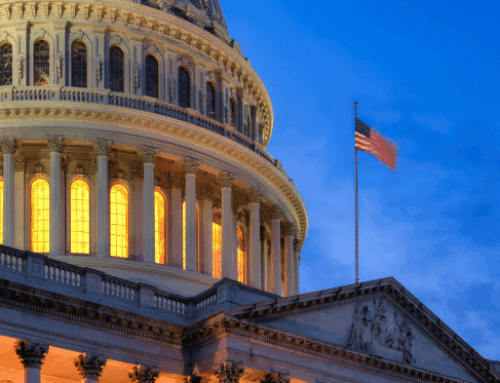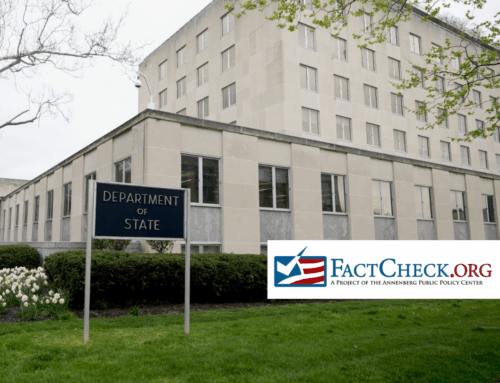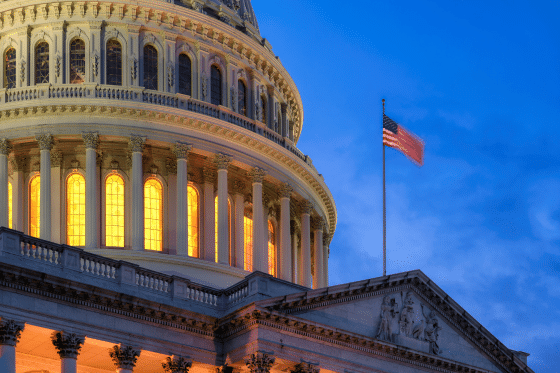The recent failure of Silicon Valley Bank harkened back to the dark days of 2008. Meanwhile, despite losing to Pratt & Whitney more than a decade ago in the battle to supply the engine for the F-35 jet fighter, Washington is suddenly abuzz about a General Electric effort to revive their alternate engine. TCS Senior Policy Analysts Wendy Jordan and Josh Sewell join Steve Ellis for a discussion about Moral Hazard and the old budget watchdog adage, “No matter how wasteful, no bad idea is ever truly dead in Washington, especially when there are billions of dollars on the line. You have to kill, kill, kill until it’s dead, dead, dead.”
Episode 42: Transcript
Announcer:
Welcome to Budget Watchdog All Federal, the podcast dedicated to making sense of the budget, spending and tax issues facing the nation. Cut through the partisan rhetoric and talking points for the facts about what’s being talked about, bandied about, and pushed to Washington, brought to you by taxpayers for common sense. And now a host of Budget. Watchdog AF, TCS President Steve Ellis.
Steve Ellis:
Welcome to All American Taxpayers Seeking Common Sense. You’ve made it to the right place. For over 25 years, TCS, that’s Taxpayers for Common Sense, is served as an independent nonpartisan budget watchdog group based in Washington DC. We believe in fiscal policy for America that is based on facts. We believe in transparency and accountability because no matter where you are in the political spectrum, no one wants to see their tax dollars wasted. It’s Tuesday, March 21st, 2023 and podcast listeners, American taxpayers, are once again beset by economic hazard on numerous fronts. Last week’s Silicon Valley Bank failure hearken back to the dark days of 2008. The bank failures, economic meltdown and the Great Recession.
Nevertheless, there are many differences. Among them, quick and repeated assurance from the Biden administration that the cold hard cash for this don’t call it a bailout, is not coming from taxpayers. And so today with that as our backdrop, I’m joined by TCS senior policy Analyst, Wendy Jordan and Josh Sewell for discussion about moral hazard and a fresh example of the old budget watchdog adage. No matter how wasteful, no bad idea is ever truly dead in Washington, especially when there are billions of dollars on the line. You have to kill, kill, kill until it’s dead, dead, dead. Did I get that right, Josh and Wendy?
Josh Sewell:
Sounds right to me.
Wendy Jordan:
Nothing’s ever dead in Washington, Steve.
Steve Ellis:
All right, well let’s dive in. Josh, let me start by asking you to define the terms for us here. What is a moral hazard?
Josh Sewell:
So in economics, a moral hazard is a situation where an economic actor has an incentive to increase its exposure to risk because it does not bear the full costs of that risk. So for example, when a corporation or a bank is insured, it may take on higher risk, knowing that its insurance will pay the associated costs if things go bad.
Steve Ellis:
And when the government pours billions of dollars into financial institutions that made bad decisions, what’s that called?
Josh Sewell:
Oh, well, that’s moral hazard.
Steve Ellis:
So the risk is here that both people or businesses won’t do due diligence to mitigate the risk if they think that they’re going to be bailed out regardless. So the customers of Silicon Valley Bank, like Roku, of whom I own some of their products, had $470 million in cash stuffed into that bank, when they knew that only $250,000 of that, a tiny fraction, is actually being guaranteed by the FDIC. And at the same time looking at the overall business, Silicon Valley Bank, they took short term deposits, like $470 million from Roku, and they tied them up in long term investments like government securities. And that all worked pretty well when there was low interest rates. But once the rates started rising and people wanted their money, they weren’t liquid enough to pay because those securities weren’t worth that much. So this is how this all plays out, right, Josh? So what are some of the concerns that you have about what the government did last week and what it has the potential of creating?
Josh Sewell:
Well, I think the biggest concern is that what precedent is being created. So for those of us who lived through the last time we had a major bank bailout and would end up becoming the Great Recession and not only live through it but also had to work on these policies, we get that this stuff is fast moving. We don’t know the full contagion so to speak. But we really got to think about what are the likely outcomes in the immediacy. But also, again, this has happened before. The details around the risks that these banks and these other financial institutions took are different, but this is a cycle for us apparently. So we got to really think about moving forward, how are we going to not induce people to take on more risk than they would, if we weren’t providing this kind of support, either before the actions or in this case, after all the chips fall.
Steve Ellis:
And we’ve now seen that the Swiss government rallied to Credit Suisse, First Boston, and that UBS is now potentially or is buying them. And so there’s a bunch of different things going on here. But one of the things I mentioned at the head, and this may make our podcast listeners query, no taxpayer money. So how are these deposits being guaranteed over at Silicon Valley Bank or other banks if it’s not taxpayer dollars?
Josh Sewell:
So right now, instead of taxpayer dollars, it’s the Federal Deposit Insurance Corporation dollars, so the FDIC. And for most of us who perhaps don’t have more than $250,000 of cash in the bank, that amount of money is insured at most of these financial institutions. So every bank, every credit union, has FDIC insurance. So if your bank goes out of business and you have less than 250,000 in your account, you’re good to go. And it actually can be different accounts at different banks. But so here, it’s not taxpayer money. Congress didn’t pass a law like they did in 2008 to rescue the banks. It’s actually they’re leaning on the FDIC to go ahead and make all these creditors whole. But the thing is the FDIC, yeah, it’s a corporation, but all the banks pay the FDIC for the insurance. So the banks are going to charge their customers, which some will be businesses and many of them will be us who have deposits there. So we’re not paying for it directly, but you’re paying for it indirectly,
Steve Ellis:
Right. And now there has been talk about increasing that coverage limit from $250,000, but I think the underlying point that you’re making here, Josh, is really solid and said, “Okay, so it isn’t technically coming from the US Treasury. It’s coming from this funded FDIC. But it’s still a government entity that that’s protecting it, so there is still this moral hazard issue.” And this isn’t the only place where we have this moral hazard issue that sprouts up in federal policy, is it?
Josh Sewell:
No, it’s not. And in one of the areas that we all love to talk about, there’s moral hazard. Farm subsidies and the farm bill.
Steve Ellis:
There you have it. If you’re keeping track at home, we are what, maybe five, seven minutes into this show and the farm bill gets mentioned.
Josh Sewell:
Sorry, I couldn’t get there sooner. But so again, we see this in federally subsidized crop insurance especially. So the fact is, when a farm business buys crop insurance, they’re actually buying a policy that guarantees one of two things. Either it pays out when you don’t have harvest, as in you don’t harvest as much crop as you expected, it’s known as a yield loss, or you don’t make as much revenue as you were expecting.
Steve Ellis:
Yield loss, revenue insurance, where’s the moral hazard?
Josh Sewell:
So the moral hazard comes in the fact that you and I are actually paying for about two thirds of the premiums charged for those insurance policies.
Steve Ellis:
So farmers are buying into the program, but only paying one third of the cost? Sounds like a pretty deal.
Josh Sewell:
It’s a great deal if you can get it. So what that means is farm businesses oftentimes end up planting crops in places where they don’t have a high likelihood of harvesting. Parts of the field or entire fields that are frequently flooded. Maybe they’re frequently dry, poorly producing in general because they’re just bad soils. And in a great year they’ll get a good crop, and in a normal year they won’t. But they’ll still get the income. So it’s a great deal for you if you can get that “insurance”. It’s not really insurance because you have that guaranteed revenue and maybe you don’t work quite as hard at avoiding a loss as you would if it was your own money at risk. And that’s the real problem here. That’s the moral hazard.
Steve Ellis:
So putting this into most of our Budget Watchdog AF listeners’ perspectives, this would be like if I drive my car and I get an accident, my rates are going to go up. But you have a farmer that doesn’t have a crop, their rates don’t go up, do they, Josh?
Josh Sewell:
Not immediately and not in the same way. Now, maybe in the long run, talk years after years and years, they can go up some. But for the most part, these policies are based on areas countywide, some was done statewide. It really doesn’t have those market signals of if you can really reduce your risk here, you will get a reward in the premiums, because the premium rates are … Even if those become actuarily sound, that’s what we’d like to say, even if the premium covers all of the risk of loss, you and I are the ones paying for that increase. Not the producer.
Steve Ellis:
And if you’re playing with house money, your appetite for risk may grow, pun intended. So besides ag, where else do we see the federal government’s hand in a moral hazard?
Josh Sewell:
Well, I think there’s a big area in that house money you just mentioned. So actually, I’ll throw this one back to you because what about federally subsidized flood insurance?
Steve Ellis:
I got that pun as well. And so yes, this is a program that actually subsidizes people to live, develop, and redevelop in harm’s way. And then of course, you have the issue of having this subsidized flood insurance availability to people, that similarly, you can continue to get it even after all lost. There may be certain restrictions and some of the premiums are going up. But just the existence of this federally backed program where the program is borrowed somewhere in the order of $40 billion from the treasury that it’s never going to repay, it certainly creates this risk. And where you actually have the federal government, the first responsibility of any government is to protect its citizens. But in this case, you actually have a program that is subsidizing them to be in a high risk environment and build and rebuild in there which threatens life and property. So that’s certainly, you’re right, a moral hazard that is being created by the government, that is doing a disservice to its citizens. All right, so those are two, crop insurance and flood insurance. Are there other areas of concern?
Josh Sewell:
Yeah, certainly. I can think of wildfires and development in areas prone to those fires. Some folks think about student loan forgiveness perhaps. Loan guarantees in general. Any sort of federal loan guarantee say for energy development projects, whether they’re so-called green energy or nuclear power plants. Pretty much anywhere that the government takes the downside risk, there’s an opportunity for moral hazard. And so that means you’ve got this area where the benefits, if things work out, go to the private folks. And if things fail, it comes to the taxpayer. So this is another thing that termed, was coined, first time I heard it back in the bailouts, privatized profits, socialized risk. So really I think the key here is that we’ve just got to be better about designing programs that actually help manage risk, rather than inducing risk and actually increasing both costs and more importantly, harms.
Steve Ellis:
Speaking of coins, another way to talk about it is heads you win, tails we, taxpayers, lose. And so certainly that fits in and I think it’s not about there being some risk. You mentioned loan guarantees and things along those lines. If the government is going to get involved in this, you’re expecting some failures to occur. Otherwise, it should all be done on the private sector. But it is about creating the programs and making sure that we’re not inducing people to take greater risks than they should and then absolving them of those risks, which then creates that same going forward.
It’s the same thing about if we know that no matter how much money we put in the bank, we’re going to get bailed out, even if they’re told that we’re only going to get bailed out to $250,000, well then we’ve just created this whole moral risk. You’re listening to Budget Watchdog, All Federal, the podcast dedicated to making sense of the budget, spending and tax issues facing the nation. I’m your host, TCS president Steve Ellis, and we continue now with Lady DOD, Wendy Jordan and Mr. Agriculture, Josh Sewell. All right, Wendy, let’s bring in here. More than a decade ago, Pratt and Whitney beat General Electric to be the exclusive engine supplier for the Pentagon’s F-35 jet fighter. Why is Washington suddenly a buzz about a fight to fund an alternate engine and at what cost?
Wendy Jordan:
Well, first, before I answer that, I have to ask how much time do we have? Because it’s a pretty long story going back to the nineties.
Steve Ellis:
Well, let’s keep it tight.
Wendy Jordan:
I’ll do my best. The argument for an alternate engine is based on the theory that you want to have more than one robust manufacturer of jet engines in the United States. If you have two producers of the same or similar products, market forces should drive down the cost of that product. Basic economics, except when market forces don’t do that, because the market is skewed. Way back, as in the 1980s, there was a periodic “competition” and since this is a podcast, our listeners can’t see me doing air quotes, a “competition” to determine the manufacturer of fighter jet engines. But this was not what we typically think of as a competition, which is winner takes all. You compete, you win or you lose. Congress would never allow that to happen when there’s two major defense contractors both trying to get part of the work. So instead, it was typically more like a 60/40 or 70/30 split, with the lower bid taking the higher percentage, 60, 65, 70% of the business for the next [inaudible 00:14:06] of engines.
Steve Ellis:
What happened with the F-35?
Wendy Jordan:
Well, after an early attempt in the nineties to dual track two engines for what was then called the Joint Strike Fighter, with General Electric and Rolls Royce teaming up against Pratt and Whitney, the engine that was eventually developed and produced for all versions of the F-35 was the Pratt and Whitney product. That left the other manufacturers out of the F-35 program altogether.
Steve Ellis:
Except it didn’t for a while,
Wendy Jordan:
Except it didn’t. Close reading of the details will tell you that there was parallel development of the alternate General Electric engine, with the primary winning Pratt Whitney engine for three years after both the Bush administration and the Obama administration tried to pull the plug on it. Congress kept funding the alternate engine until just 11 years ago, 2012, when it finally died.
Steve Ellis:
It died? Or so budgetary legend would have you believe?
Wendy Jordan:
Well, recently the Air Force decided to upgrade the current Pratt Engine to allow the F-35 to perform some new missions. Last year, during the budget hearings, the Secretary of the Air Force testified that it would cost about $6 billion to get an alternative engine, which is called, because we can never have anything named simply in the Pentagon, it’s officially called the Adaptive Engine Transition Program, or AETP. To get the alternative engine into production would be $6 billion. And so they decided to go with an upgrade of the current Pratt engine instead. Well-
Steve Ellis:
But yeah, that’s not going to sit well. You’ve basically said, “Hey, we’ve got to do more work to this one engine”, and then I’m sure that the lobbyists and GE and Rolls Royce kept their nose to the ground and ready to go and so?
Wendy Jordan:
Well, General Electric and its backers on the hill, and they were still stung by the original decision to go with a single manufacturer. They prefer there be a new competition for the next generation engine. So this is setting up to be a tussle on Capitol Hill on how to proceed.
Steve Ellis:
And so Wendy, if I recall correctly, because I remember putting my signature on it, we joined with some other groups on a letter to Capitol Hill about this very development and about this potentially $6 billion increased expense?
Wendy Jordan:
Yeah. Early in February, we joined a number of other fiscal conservative groups on a letter to the Secretary of Defense, Lloyd Austin, asking him not to request funds for a second engine for the latest upgrades to the F-35. We like to think our letter made a difference, and we were very happy to see the President’s budget request for FY ’24 does not include any money for the very simply named Adaptive Engine Transition Program. Now the fight really begins in Congress, in my opinion. What do you think of that, Steve?
Steve Ellis:
Well, if past his prologue, we saw that the alternate engine continued for three years after the president said no in the budget. And it wasn’t until we had the pressures in 2012 right after the BCA and the Budget Control Act, that the Tea Party, that basically was the death knell for it. So it’s harder to revive than to keep things going, but I definitely think that’s going to be a big fight.
Wendy Jordan:
And three years is not actually a long time for that type of fight to continue. In Washington speak, three years isn’t a long time. But I think it’s unlikely General Electric’s simply going to accept it. “Okay, the president’s budget request didn’t ask for money for us”, and that they’ll go quietly.
Steve Ellis:
The other thing that GE certainly has to their benefit is geography. They’re doing this in Ohio and Indiana. Whereas Pratt and Whitney’s in Connecticut-
Wendy Jordan:
Connecticut, right.
Steve Ellis:
And so certainly, that’s going to be one of those pressure points that is going to be brought to bear.
Wendy Jordan:
Not that we would argue that politics or geographic politics would ever come into such a decision.
Steve Ellis:
Heavens no. All right. Since we’ve been talking so much about the F-35 and what gets it going, the engine, so what about the F-35s and what the services got in the President’s budget request?
Wendy Jordan:
Okay, I happen to have those numbers right here. Careful listeners of our podcast know that three military services fly three different versions of the F-35. And so when three military services are buying the same aircraft, you tend to get fairly large buys over the course of a year. This year, there are 83 total airframes being requested by the Navy Marine Corps and Air Force. And if you add up the procurement, the advanced procurement and the research and development funds across those three services, you end up with $13.7 billion of the Pentagon’s top line of 842 billion. It’s a lot of money.
We are also going to do some digging. The details are trickling out unevenly, but I want to go through all the mil-con requests, the military construction requests, for each of the military services, and figure out how much money is requested for military construction that only serves the F-35 program. That’s a little hard to pull out because oddly, for instance, the Air Force has a child development center listed as an F-35 Child Development Center. And we are unaware that F-35s actually have children. So we are assuming that it is not just the offspring of people who fly or service F-35s who would be going to that child development center. So I think it would be an overstatement to put all of that money against the F-35 program.
Steve Ellis:
I would not at all be surprised if Josh’s kids are out in the yard at some point this spring with their arms out flying like they’re an F-35. So don’t underestimate the F-35 child. There you have it, podcast listeners. For American taxpayers, fiscal hazards abound. We’ll keep calling it like we see it. This is the frequency, market on your dial. Subscribe and share and know this: Taxpayers for Common Sense has your back America. We read the bills, monitor the earmarks, and highlight those wasteful programs that poorly spend our money and shift long-term risk taxpayers. We’ll be back with a new episode soon. I hope you’ll meet us right here to learn more.










